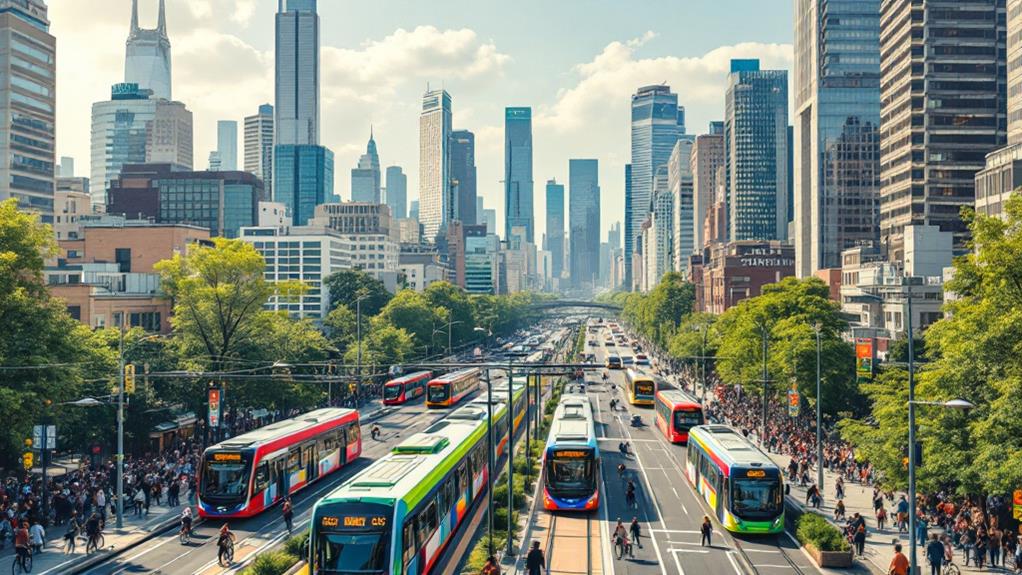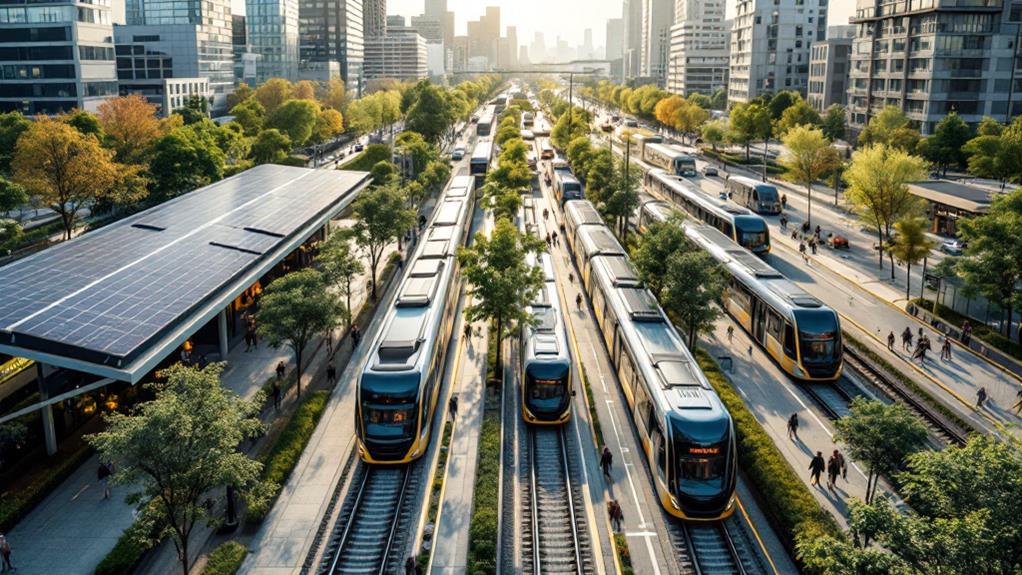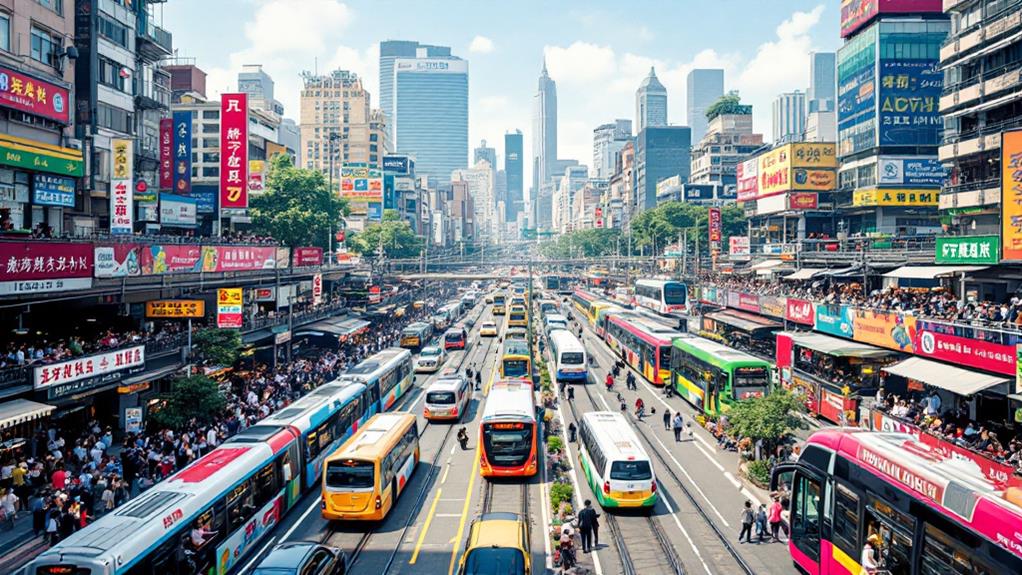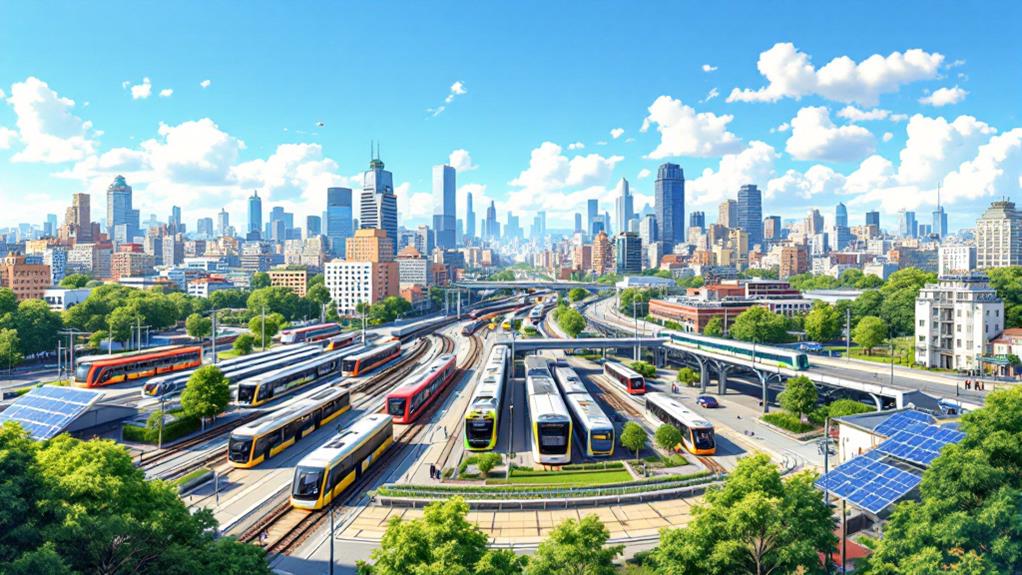The Role of Public Transportation in the World’s Largest Urban Areas

In the world's largest urban areas, public transportation is essential to economic and social advancement. It cuts travel costs and time, enhances productivity, and reduces traffic congestion. This diminishes the carbon footprint markedly. Every dollar invested in transit creates around $5 in economic returns and numerous jobs, while increasing property values. Public transit is safer and provides access to opportunities for marginalized groups. However, challenges include aging infrastructure and access issues. By investing in sustainable and technological advancements, cities can tackle these obstacles. Investigate more about how public transit shapes urban life and the potential challenges it faces.
Importance of Urban Mobility
Urban mobility is the backbone of thriving cities, driving both economic and social progress. When you have access to public transportation, you're part of a system that fuels economic growth by reducing travel times and costs. Imagine shaving minutes off your daily commute, freeing up time for more productive activities. Efficient urban mobility doesn't just make life easier; it elevates economic productivity by connecting you to job opportunities you might otherwise miss.
Public transportation plays a significant role in reducing traffic congestion. When more people use trains, buses, and subways, fewer cars clog the roads. This not only saves you time but also lessens your individual carbon footprint, promoting a greener and more sustainable way of commuting.
Investing in public transit infrastructure isn't just smart—it's lucrative. For every dollar invested, cities can see about five dollars in economic activity, supporting thousands of jobs. This kind of growth is essential, especially as urban populations swell, with projections showing a rise to 68% by 2050.
Furthermore, improved urban mobility fosters social equity. With better access to public transport, marginalized communities can experience higher social mobility, opening doors to greater opportunities for all.
Challenges in Urban Transport
Charting the maze of urban transport challenges, cities worldwide face mounting pressure from rapidly growing populations. The strain on public transport systems becomes palpable as projections suggest a staggering 2 billion increase in the urban population by 2045. This surge demands efficient urban transport solutions, yet traffic congestion already wreaks havoc on urban economies. Billions are lost annually due to productivity drops linked to transportation delays and inefficiencies, underscoring the essential need for robust urban planning.
Access to public transport is another hurdle. As of 2019, only 50% of urban dwellers enjoyed convenient access, limiting mobility and economic opportunities for the other half. This disparity highlights the pressing need for improved transportation infrastructure to improve connectivity within cities.
Environmental concerns also loom large, with urban transport responsible for about 24% of global CO2 emissions. This statistic emphasizes the urgency of addressing transportation's environmental impact in densely populated areas. Furthermore, aging transportation infrastructure compounds these challenges. The escalating maintenance costs necessitate significant investment to keep public transport systems reliable and efficient as cities expand. Consequently, without strategic urban planning and investment, these challenges threaten urban livability and economic significance.
Infrastructure and Sustainability

Investing in public transportation infrastructure doesn't just ease congestion; it slashes carbon emissions by 63 million metric tons annually, playing a crucial role in urban sustainability efforts. You might not realize it, but by choosing public transit over personal vehicles, you're contributing to a cleaner environment. Personal vehicles account for 24% of global CO2 emissions, so opting for public transit can greatly reduce your carbon footprint.
Efficient transport infrastructure does more than cut emissions. It enhances urban economic sustainability, with cities often seeing a 10-15% rise in economic activity. By enhancing public transit systems, you're supporting a thriving urban economy. Plus, access to public transit reduces urban sprawl, promoting compact city designs. This makes cities more livable and reduces the costs associated with service delivery.
Sustainable transport isn't just about buses or trains. Integrating cycling and walking into public transportation planning further minimizes environmental impacts. By embracing these options, you're not only helping the environment but also promoting a healthier lifestyle. So, when you support investments in public transportation, you're advocating for a sustainable future. It's a choice that supports both the planet and urban communities.
Technological Innovations
Building on the foundation of sustainable infrastructure, technological innovations are transforming public transportation, making it more efficient and user-friendly. In urban areas, autonomous vehicles and smart ticketing systems are at the forefront, enhancing operational efficiency and convenience. With these advancements, you can expect a smoother, more reliable travel experience that promotes increased ridership.
High-speed rail systems are another significant development, slashing travel times between major urban centers and enhancing intercity connectivity. These systems not only redefine long-distance travel but also integrate seamlessly with existing modes of transportation, creating a cohesive public transport network.
Bike-sharing programs have also adopted technology, offering real-time availability information through mobile apps. This makes cycling a more attractive option and guarantees you can always find a bike when you need one, enhancing urban mobility.
Ridesharing services are transforming urban transportation by using advanced algorithms to optimize routes and reduce congestion. They offer a more flexible and user-oriented approach to public transport, tailored to your specific needs.
Lastly, intelligent transport systems (ITS) use real-time data to improve traffic flow and reduce delays. These systems guarantee that public transportation in urban areas is managed efficiently, enhancing your commuting experience.
Economic and Social Impacts

Public transportation isn't just about getting from point A to point B; it greatly impacts the economy and society in urban areas. Investing in public transit yields impressive economic benefits, with every dollar spent generating about five dollars in return. This investment also creates approximately 50,000 jobs for each billion dollars spent, markedly enhancing local economies. In urban areas, public transit is not only economically beneficial but also ten times safer per mile than personal vehicles, reducing accident risks and improving community safety.
Public transit plays a fundamental role in promoting social equity. By providing reliable transport options, it expands access to economic opportunities and supports higher social mobility, especially for marginalized communities. With better access to jobs, education, and key services, public transit helps level the playing field, fostering a more inclusive society.
Moreover, around 87% of public transit trips positively impact local economies, highlighting its significant role in community connectivity. These trips support local businesses and services, creating a more lively urban environment. By choosing public transit, you're not just opting for convenience but contributing to the social and economic fabric of urban areas.
Influence on Property Values
Imagine living in a lively urban area where the value of your home keeps climbing, thanks to the nearby transit station. Public transportation plays an essential role in increasing property values in densely populated urban communities. Studies show that homes near transit stations can see a property value increase of up to 24% compared to those farther away. This trend isn't just a fluke. The presence of reliable public transport systems like rail transit stations directly correlates with higher residential property values.
Take Seoul's Subway Line 5, for example. Research highlights its positive impact on residential property values, proving the economic influence of transit accessibility on urban real estate. When public transportation improves, so do rental prices and property valuations, making your investment in such areas even more rewarding. New transit options don't just elevate property values; they also increase demand for housing, pushing urban communities to thrive.
As transit stations become more accessible, they often lead to higher rental prices and more compact living spaces. This shift reflects a broader trend towards efficient urban living, where public transportation becomes a key driver of property value appreciation in densely populated areas.
Policy and Environmental Considerations

When you look at urban planning, one can't overlook the importance of policy and environmental considerations in shaping public transportation. You see, urban planners play an important role in creating systems that prioritize accessibility and reduce the environmental impact. By investing in public transportation, cities can greatly decrease urban traffic congestion. Implementing ideal pricing strategies could lead to a 15% reduction in car trips, highlighting the potential of public transit to ease city traffic.
Moreover, public transportation is critical for Sustainable Development. With urban transportation contributing 24% of global CO2 emissions, enhancing public transport systems becomes necessary in cutting down these emissions. You can help achieve sustainability goals by integrating sustainable transport options like cycling and walking, potentially reducing carbon emissions by 63 million metric tons annually.
Accessibility to public transportation is also key for social equity. Communities with better transit options often see higher social mobility and economic productivity. The economic return is impressive too—every dollar invested in public transit yields approximately five dollars in economic benefits. So, when urban planners focus on policy and environmental considerations, they lay the groundwork for a sustainable and equitable urban future.



